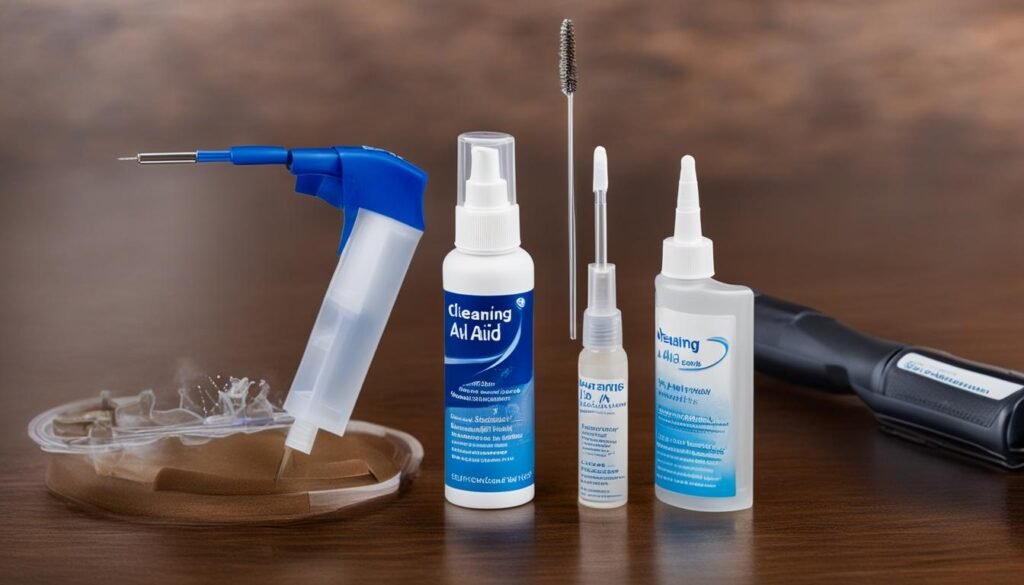Welcome to our comprehensive guide on how to clean hearing aid tubes. Proper cleaning is essential for maintaining the functionality and lifespan of your hearing aids. This section will provide a step-by-step guide to effectively clean your hearing aid tubes and keep your devices in optimal condition.
Before we dive into the cleaning process, let’s briefly discuss the importance of cleaning your hearing aids. Regular cleaning ensures optimal sound quality and helps prevent wax blockage, which can impair your hearing ability. By following the proper cleaning techniques, you can extend the lifespan of your hearing aids and enjoy clear and crisp sound.
Key Takeaways:
- Regularly cleaning your hearing aid tubes is crucial for maintaining optimal sound quality.
- Proper cleaning techniques help prevent wax blockage, improving your ability to hear.
- Cleaning your hearing aids regularly can extend their lifespan.
- Follow the step-by-step guide provided in this section for effective cleaning.
- Consult a professional for professional cleaning and maintenance of your hearing aids.
Identify Your Hearing Aid Type
Before cleaning, you must identify your specific type of hearing aid. There are three primary styles of hearing aids: Behind-the-Ear (BTE), Receiver-in-the-Canal (RIC), and In-the-Ear (ITE). Each type has its own distinct components and cleaning requirements.
BTE Hearing Aids: BTE hearing aids consist of a small plastic case behind the ear and a tube connecting to an earmold or earpiece. These hearing aids are typically more extensive and more visible than other types. To clean BTE hearing aids, remove the tubing and wash it separately from the other components.
RIC and ITE Hearing Aids: RIC hearing aids and ITE hearing aids are smaller and more discreet compared to BTE models. RIC hearing aids have a slight case behind the ear, connected to the receiver or speaker by a thin wire. ITE hearing aids are custom-made to fit inside the ear. Both types require specific cleaning techniques to ensure optimal performance.
Why Identification Matters
Identifying your hearing aid type is crucial because each style has unique cleaning requirements. Using the wrong cleaning methods or tools can damage your hearing aids and reduce effectiveness. By correctly identifying your hearing aid type, you can ensure you properly maintain and clean your device.
The following section will discuss the necessary cleaning tools for each hearing aid type and the step-by-step cleaning process for both BTE and RIC/ITE hearing aids. Cleaning your hearing aids correctly will help extend their lifespan and maintain optimal sound quality.
Gather the Necessary Cleaning Tools
Before you begin cleaning your hearing aids, gathering the necessary cleaning tools is essential. Having the right tools will ensure you can effectively clean your hearing aids without causing any damage. Here are the basic cleaning tools you’ll need:
- BTE Cleaning Tool: If you have Behind-the-Ear (BTE) hearing aids, you’ll need a cleaning tool with a brush and wire. This tool is specifically designed to remove debris and wax from the tubing and other components of BTE hearing aids.
- RIC and ITE Cleaning Tool: For Receiver-in-the-Canal (RIC) and In-the-Ear (ITE) hearing aids, a different cleaning tool is required. This tool should have a brush and wax loop, which are used to remove wax and clean the dome tip or receiver.

Additionally, before cleaning your hearing aids, remember to remove the battery. This step is crucial to prevent any potential damage to the electronic components during the cleaning process.
Ensuring you have the proper cleaning tools and removing the battery, you’ll be well-prepared to clean your hearing aids effectively.
Read Also: Can syphilis cause hearing loss
Cleaning Process for BTE Hearing Aids
When cleaning behind-the-ear (BTE) hearing aids, following a thorough and careful process is essential. This will help maintain the functionality and longevity of your device. The cleaning process for BTE hearing aids involves three main steps: tubing removal, tubing cleaning, and tip cleaning.
Step 1: Tubing Removal
To begin cleaning your BTE hearing aids, gently remove the tubing. Be cautious and steady to avoid any damage. This step allows for better access to the tubing, which can accumulate debris and earwax over time.
Step 2: Tubing Cleaning
After removing the tubing, it’s time to clean it. Start by using a wire specifically designed for hearing aids to remove any debris or earwax from the tubing carefully. Be gentle and thorough while cleaning to ensure optimal performance.
Step 3: Tip Cleaning
Next, clean the tip of the BTE hearing aid using a brush and a microfiber cloth. Gently brush away any visible debris or earwax from the end, ensuring not to apply excessive pressure. Once touched, wipe the end clean with the microfiber cloth to remove any remaining particles.
After completing the cleaning steps, it’s essential to reattach the tubing firmly and securely to ensure proper functionality. Remember to reattach the battery if it was removed during the cleaning process.
Regularly following these cleaning steps can keep your BTE hearing aids in optimal condition and ensure a clear and compelling sound experience.
Cleaning Process for RIC and ITE Hearing Aids
When it comes to cleaning RIC (Receiver-in-the-Canal) and ITE (In-the-Ear) hearing aids, a different approach is required compared to BTE (Behind-the-Ear) devices. These hearing aids have specific cleaning requirements to maintain functionality and prolong lifespan.
1. Wax Removal: One common issue with RIC and ITE hearing aids is wax buildup. To remove wax, use a wax loop tool. Gently insert the loop into the dome tip or receiver, and carefully scrape away any visible wax. Be cautious not to push the wax further into the device.
2. Microphone Port Cleaning: The microphone ports can accumulate debris over time, affecting the sound quality. Use the provided cleaning tool or a soft-bristled brush to clean the microphone ports. Gently brush away any dust or particles.
3. Tip and Body Cleaning: Clean the dome tip or receiver using mild soap or disinfectant wipes. Avoid using alcohol-based solutions as they can damage the materials. Wipe down the entire hearing aid body, including buttons and switches, using a microfiber cloth to remove dirt or oil.
By following these cleaning steps regularly, you can ensure that your RIC and ITE hearing aids stay in optimal condition. Remember to be gentle and avoid harsh cleaning methods that could cause damage. Consult your hearing healthcare professional for guidance if you have concerns or questions about the cleaning process.
Read Also: How to Clean Hearing Aid Molds
Tips for Cleaning RIC and ITE Hearing Aids:
- Remove wax buildup regularly to prevent blockage and maintain sound quality.
- Take extra care when cleaning the microphone ports to avoid damaging the sensitive components.
- Use a non-alcohol-based cleaning solution or disinfectant wipes to clean the dome tip or receiver.
- Be gentle when wiping down the hearing aid body to avoid accidentally pressing buttons or switches.
- Consider using a drying kit to remove moisture and prevent damage to the hearing aids.
Following these cleaning tips and incorporating regular maintenance into your routine can keep your RIC and ITE hearing aids functioning optimally for years.
Frequency of Cleaning and Final Tips
Regularly cleaning your hearing aids is essential for maintaining optimal performance and extending lifespan. By incorporating a simple cleaning routine into your daily habits, you can prevent problems such as wax blockage and ensure that your hearing aids continue to provide clear and reliable sound.
Here are some critical tips for daily cleaning:
- Remove your hearing aids and inspect them for any visible debris or wax buildup. Use a soft, dry cloth or tissue to remove dirt or moisture.
- Check the microphone ports and openings for wax or other obstructions. Clean them using a small brush or a wax loop explicitly designed for hearing aids.
- Take extra care when cleaning the tubes or receiver of your hearing aids. Follow the manufacturer’s instructions for your specific type of hearing aid to ensure proper cleaning and prevent damage to these delicate components.
- Consider using a drying kit or dehumidifier to remove excess moisture from your hearing aids. This can help prevent the growth of bacteria and prolong your device’s lifespan.
Remember, it’s important to troubleshoot the issue if you experience any difficulties or reduced sound quality despite regular cleaning. Try changing the batteries, replacing the wax filters, or consulting your hearing healthcare professional for further assistance.
How long does tinnitus last after a car accident? Our exclusive feature on provides insights into post-traumatic tinnitus and recovery timelines.
While daily cleaning is crucial, it is also recommended to have your hearing aids professionally cleaned at least once a year. Professional cleaning can help remove stubborn wax buildup, thoroughly inspect your device for any issues, and ensure all components function optimally.
Following these cleaning tips and incorporating regular maintenance into your routine, you can enjoy clear and comfortable sound from your hearing aids while extending their lifespan.
Conclusion
In conclusion, keeping your hearing aids clean is essential for maintaining optimal sound quality and prolonging their lifespan. Regular maintenance and cleaning routines can significantly improve the performance and longevity of your devices.
By properly cleaning your hearing aids, you can prevent wax and debris buildup, which can obstruct the sound output and reduce their effectiveness. Regular cleaning also helps to protect the delicate components of your hearing aids from damage, ensuring they continue to function correctly.
Remember to follow the step-by-step cleaning guide provided in this article, considering the specific cleaning requirements for your type of hearing aid. Using the appropriate cleaning tools and techniques will ensure thorough and safe cleaning.
In addition to regular cleaning, it is also recommended to schedule professional cleanings for your hearing aids. A professional cleaning can help address any stubborn debris or buildup that may be difficult to remove with regular cleaning methods. These cleanings can be done by an audiologist or hearing healthcare professional.
Frequently Asked Questions
What are the three primary styles of hearing aids?
The three primary styles of hearing aids are Behind-the-Ear (BTE), Receiver-in-the-Canal (RIC), and In-the-Ear (ITE).
What cleaning tools do I need for BTE hearing aids?
For BTE hearing aids, you will need a cleaning tool with a brush and wire.
What cleaning tools do I need for RIC and ITE hearing aids?
RIC and ITE hearing aids require a brush and wax loop cleaning tool.
Should I remove the battery before cleaning my hearing aids?
Yes, removing the battery from your hearing aid before cleaning is essential to avoid any potential damage.
How do I clean the tubing on BTE hearing aids?
The cleaning process for BTE hearing aids involves removing the tubing, cleaning it with a wire and microfiber cloth, and then cleaning the tip with a brush and cloth.
How do I clean the dome tip or receiver on RIC and ITE hearing aids?
To clean the dome tip or receiver on RIC and ITE hearing aids, you can use a wax loop to remove wax, clean the microphone ports, and wipe down the hearing aids with a microfiber cloth.
How often should I clean my hearing aids?
It is recommended to clean your hearing aids daily or as needed to maintain optimal performance.
What should I do if my hearing aids have wax blockage?
If you experience wax blockage, you can use a wax loop or seek professional cleaning assistance to remove the wax.
How can I troubleshoot reduced sound quality in my hearing aids?
If you notice reduced sound quality, try cleaning the microphone ports and ensure the hearing aids are correctly inserted. If the issue persists, consult with your hearing healthcare professional.
Can I get my hearing aids professionally cleaned?
Yes, many hearing healthcare professionals offer professional cleaning services for hearing aids.



